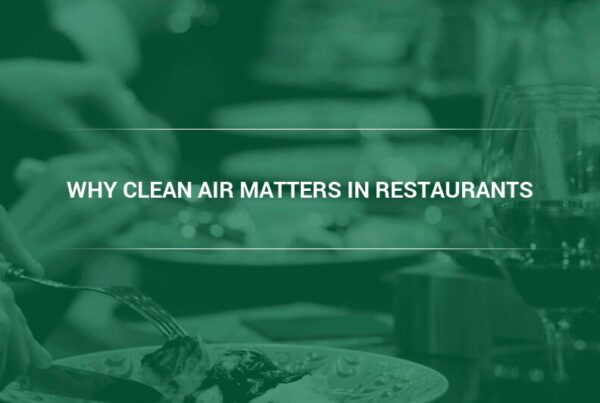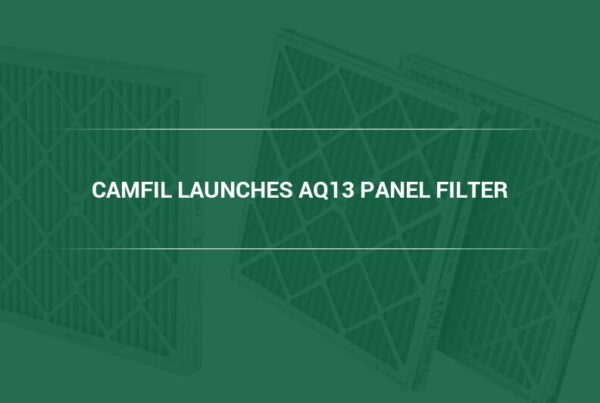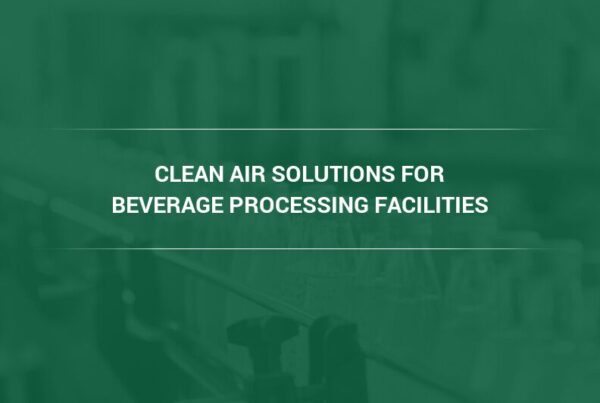Food processing facilities face unique and complex challenges in maintaining clean air. The movement of raw materials, open processes, fluctuating temperatures and high humidity all create ideal conditions for airborne contamination. Standard HVAC systems and filters simply aren’t enough to protect sensitive production zones from bacteria, mold spores and allergens.
Adopting advanced air filtration solutions is essential to meeting regulatory requirements and consumer demand for food safety standards. From preventing cross-contamination to reducing energy costs and extending equipment life, the right filtration systems support nearly every facet of food production.
The relationship between air quality and food product integrity is intricate. Airborne contaminants can settle on surfaces and ingredients, directly impacting shelf life, taste and safety. This is why air handling must be treated as a proactive strategy, not a reactive remedy.
Read further to learn how a comprehensive clean air strategy combining high-efficiency air filters, air cleaners and proven contamination control practices can protect food safety, optimize performance and secure regulatory compliance.
Contaminants in Food Processing Facilities
The effects of contamination in food processing are twofold, threatening both the health of consumers and the bottom line of producers. From a financial perspective, contamination can lead to significant product loss during production, increased waste, reduced shelf life and costly product recalls and returns. These expenses can place a substantial burden on a facility’s profitability and undermine brand reputation which is very difficult to recover
Far more critical, however, is the risk that contaminated food poses to public health. Airborne pathogens, bacteria and viruses can cause a wide spectrum of foodborne illnesses, ranging from mild gastrointestinal discomfort to life-threatening infections. Vulnerable groups, including infants, young children, the elderly, pregnant women and individuals with weakened immune systems, face the highest risk of severe illness or complications.
Particles such as dust, bacteria, mold, and yeast can infiltrate products and cause health problems for consumers. One of the most common vectors for contamination is bioaerosols, microscopic liquid or solid particles suspended in the air that carry microbes. Bioaerosols are frequently generated when microbial sources are disturbed. For example, high-pressure hoses used to clean outside holding pens can propel particles into the air, where they remain suspended for minutes or hours and depending on airflow and particle size, can be drawn into the plant through nearby poorly filtered HVAC units. Other common contributors include unfiltered compressed air lines, poorly maintained HVAC systems and even foot or vehicle traffic moving through stagnant water. Bioaerosols can also originate outside the facility, traveling from neighboring buildings or fields before settling onto contact surfaces or directly onto food.
Among the most prevalent bioaerosol contaminants are microorganisms such as Salmonella, E. coli, Listeria, Bacillus and Clostridium. Yeasts and molds are also frequently encountered, especially in environments where bacterial growth is inhibited, like foods preserved with high salt concentrations. Viruses, including norovirus and hepatitis A, further complicate contamination control due to their resilience and ease of transmission.
To combat these risks, food processing facilities must be designed and maintained to limit exposure to airborne contaminants. Effective measures include optimizing the placement and performance of HVAC systems, maintaining positive air pressure in sensitive areas and implementing high-efficiency air filtration capable of capturing and neutralizing bioaerosols. Coupled with rigorous sanitization protocols and environmental monitoring, these strategies form a critical line of defense to safeguard both product integrity and public health.
Regulatory Standards Governing Air Quality in Food Processing
Maintaining clean air at food processing facilities isn’t just a best practice, it’s a regulatory imperative enforced by multiple agencies and frameworks. While no single rule prescribes universal air quality thresholds for every product, the FDA, USDA and HACCP principles collectively define stringent requirements and protocols to prevent contamination and protect public health.
The FDA sets the baseline for most human food facilities under the Current Good Manufacturing Practice (CGMP) regulations, detailed in 21 CFR Part 117. These rules mandate that buildings be designed and maintained to prevent airborne hazard contamination. Facilities must have adequate ventilation, filtration and airflow control to minimize vapors, odors and particulates that could compromise food safety. Under the Food Safety Modernization Act (FSMA), processors must also establish risk-based preventive controls, which often include strategies for controlling airborne contaminants.
The USDA regulates meat, poultry, and egg products, requiring facilities to comply with 9 CFR Part 416 sanitation standards. These rules stipulate that ventilation systems must effectively control condensation, noxious fumes and airborne contaminants. USDA inspectors routinely verify that ventilation and air handling equipment are sanitary, well-maintained and sufficient to prevent product adulteration.
Hazard Analysis and Critical Control Points (HACCP) programs are mandatory for certain food products, but many processors choose to follow those guidelines on their own accord. HACCP is an internationally recognized framework requiring facilities to assess risks in their processes and establish preventive measures where necessary. For example, if a hazard analysis identifies potential for airborne pathogens or allergens, the facility must define controls such as HEPA filtration, positive air pressure zones or specialized air change rates to mitigate the risk.
Taken together, these regulations, standards and recommendations underscore a clear message: clean air is fundamental to food safety, regulatory compliance and consumer trust. Well-designed ventilation systems, validated air filtration technology and rigorous environmental monitoring enable food processors to demonstrate that their facilities are equipped to control airborne hazards at every step.
Role of Air Filtration in Controlling Contamination
An air filter is just one part of the broader, more sophisticated HVAC system that governs the ventilation within a food processing facility. This system is responsible for supplying air that meets precise requirements for temperature, humidity and pressure, all of which are essential to maintaining a safe product and a healthy working environment.
The choice and performance of an air filter have a direct influence on food safety programs and those tasked with upholding strict sanitation standards. Overlooking the importance of carefully evaluating a filter’s capabilities can lead to consequences far beyond contamination risks. Ineffective filters can drive up energy consumption, jeopardize positive pressure in critical process zones, increase equipment wear, raise labor demands and generate excessive waste headed to landfills, all of which escalate operational costs and erode a facility’s efficiency.
Generally speaking, food processing facilities rely on as many as four distinct categories of equipment, designed for air to flow through and contain air filters.. The first is the primary HVAC system, usually installed on the roof, which supplies fresh air and regulates the building’s temperature and humidity. The second category would be make-up air handling units, which provide fresh outside air into the facility. These units do not have heating or cooling capabilities. A third includes process filters, specialized filtration components that protect the air entering specific pieces of equipment. A coalescing filter is a type of process filter. Another type would be a HEPA filter safeguarding aseptic systems. The last type consists of independent, stand-alone air cleaners, which are often positioned near zones that are prone to generating contaminants.
Even the most carefully engineered air handling infrastructure will fall short without selecting the right filters for each application. To effectively trap bioaerosols and other airborne hazards, facilities should use high-efficiency filters. It is important to choose filters carrying both a MERV and MERV-A rating. The “A” designation—for example, MERV 14-A—indicates the filter has been evaluated under conditions that reflect real-world use, ensuring its performance remains consistent over time rather than declining as it loads with particles.
In areas that are known sources of internal contamination or where maintaining elevated air pressure is critical, stand-alone air purification systems can provide an additional layer of defense against airborne pollutants.
Ultimately, the responsibility to produce safe food and beverages falls on the facility operators. They must determine which filtration approach best fits specific processes, whether that means specifying certain MERV ratings, integrating HEPA filters or deploying supplemental air purification units. Because no two operations are identical, there is no universal solution. For this reason, partnering with an experienced air filtration professional is strongly recommended to ensure you select the right air filters.
The Necessity of Positive Pressure
An essential element of any effective food safety strategy is controlling the pressure and the direction in which air moves throughout the facility. Ideally, the air pressure inside a food processing plant should be positive, meaning it is higher than the pressure outside the building. This pressure differential drives air outward through open doors, windows and even small structural gaps, acting as a protective barrier that keeps airborne contaminants from entering the building envelope.
Within the facility, pressure gradients should be carefully managed so that the most critical production areas maintain the highest pressure levels, while less sensitive zones have lower pressures. This setup ensures that any internally generated particles or microbes are contained and flow away from high-risk areas, preventing contaminants from traveling, for example, from a storage warehouse into the processing line.
Air that has been conditioned for temperature and humidity as well as filtered to a high level, is a very valuable asset for a food processor. Camfil’s advanced air filters are engineered to deliver the lowest average pressure drop to allow greater volumes of air to be moved efficiently, helping maintain strong positive pressure throughout the building. Increased airflow also provides the flexibility to control and direct air currents in ways that support the highest standards of food safety, tailored to the unique configuration of each plant.
Clean Air Zones – Designing a Controlled Airflow Strategy
Unlike other manufacturing industries, food processing facilities handle an exceptionally diverse range of raw materials, from hot and cold ingredients to raw, cooked and even slaughtered products. Every stage of production comes with its own set of contamination risks, making it essential to choose air filtration solutions precisely matched to each process step.
At the front end, incoming raw materials are typically sorted, sifted and prepped, activities that often create substantial product dust. This airborne dust is captured at the source through localized hoods and conveyed through ductwork to cartridge-style dust collectors positioned outside the building.
The core processing zones of the facility are where the most critical production operations occur. Here, the greatest volume of clean, conditioned air is delivered, usually by rooftop air handling units equipped with multiple stages of filtration to protect against contaminants. Process machinery such as aseptic packaging lines rely on this clean ambient plant air as their intake source, making filtration performance in these areas especially vital.
Spaces dedicated to quality control and taste testing are commonly segregated from production zones and safeguarded with HEPA filters to preserve product integrity. Temporary storage rooms and finished goods warehouses, including cold storage facilities, demand close management of both temperature and airflow to maintain food safety standards.
Beyond production spaces, a food processing plant also includes offices and administrative areas that support daily operations. These environments house a facility’s most valuable asset, its people, and ensuring employees have access to clean, healthy air is equally important as protecting the product itself.
Key Camfil Solutions for Food Industry Applications
When it comes to protecting food quality and ensuring compliance, Camfil offers a comprehensive suite of air filtration and dust collection solutions engineered specifically for the unique demands of food processing environments. From limiting microbiological cross-contamination caused by mold, bacteria, and viruses to capturing fine dust and volatile organic compounds, Camfil’s air filtration products help safeguard every stage of production. With a portfolio designed to meet the strictest industry standards, Camfil empowers food manufacturers to maximize operational excellence, achieve high energy efficiency and keep total cost of ownership low.
As noted above, air filtration solutions must be customized for each specific facility for the best operational outcomes. Our general air filtration recommendations are:
- Pre-filters rated MERV 8 for initial contaminant capture
- Final filters rated MERV 13A through 16A for critical applications
- HEPA filters for sensitive food production areas
Camfil Product Applications:
- Durafil ES3 V-bank style air filters: High-capacity solutions for demanding food processing environments
- Hi-Flo ES bag filters: Reliable performance for large-format food manufacturing facilities
- Cam-Flo XLT bag filters: Specialized solutions for high moisture environments and older AHU systems with weather protection challenges
- CamCleaner Horizontal air purifier: Portable air cleaning for targeted contamination control and facility flexibility
- Megalam and Absolute HEPA air filters: Tested and certified HEPA filters for aseptic, dairy and extended-shelf-life food processing
Case Studies and Success Stories
- One of North America’s largest food companies, also one of the nation’s leading specialty potato providers to restaurants and other food service establishments, was experiencing high contaminant levels over the batter and fry lines during sweet potato production. Camfil created a customized solution for high-, medium- and low-contamination areas. Read the full story.
- A well-known baking facility in Pennsylvania faced significant challenges with processes that produced excessive flour dust. These airborne particles accumulated on equipment surfaces and migrated into the return air exhaust ductwork, as well as other parts of the ventilation system. Camfil surveyed the site and installed two CamCleaners with 2,000 CFM capacity each in optimal areas to capture the airborne flour and improve airflow patterns. High-quality air filters were installed in the rooftop air handling units to improve overall air filtration. Read the full story.
- One of America’s largest beef processing plants was struggling with contaminants infiltrating food production areas due to subpar air filter performance. Frequent filter replacements had become a costly, time-consuming burden, while overall airflow and air quality were at risk. To address the problem, Camfil was brought in to conduct a comprehensive Life Cycle Cost analysis, modeling how different air filters perform under the facility’s specific operating conditions. Based on the findings, Camfil-recommended filters were installed in three of the five air handling units (AHUs). Ongoing performance tracking demonstrated substantial savings by reducing energy consumption, labor requirements and disposal costs. Read the full story.
ROI and Operational Benefits
When evaluating air filters, it’s essential to look past the upfront price tag and consider all the expenses that accumulate over the filter’s entire lifespan. Factors such as energy usage, gradual loss of performance, labor for installation and replacement and disposal fees all contribute to the total cost of ownership (TCO). TCO is a comprehensive financial assessment that helps buyers understand both the direct and indirect costs tied to a product or system over time.
Filters with a low initial cost often clog more quickly, which drives up operational expenses as HVAC systems have to work harder and consume more energy to maintain airflow. By contrast, Camfil filters retain their efficiency much longer, capturing contaminants and preserving optimal airflow up to two or three times longer than conventional low-cost alternatives. This not only results in lower energy consumption but also reduces the frequency of filter changes, which means fewer replacement filters, less labor and less waste headed to landfills. All of these advantages further reduce overall TCOS.
To help facilities make informed decisions, Camfil offers the Life Cycle Cost (LCC) Software, an advanced modeling tool that calculates the TCO for various filter options under real-world conditions. The software analyzes factors such as filter price, energy usage, labor, carbon footprint and disposal costs. It also recommends the ideal pressure drop point for filter replacement to optimize energy savings and extend filter life as much as possible.
Don’t be swayed by bargain filters that appear cheaper upfront but end up costing you far more over time. When you’re ready to invest in new air filters, be sure to evaluate the complete picture and consider the true TCO to achieve the best long-term value and performance.
Conclusion
Clean air solutions are critical for success in food processing. From protecting product integrity and preventing costly recalls to ensuring regulatory compliance and supporting a safe working environment, effective air filtration is the backbone of a resilient, efficient operation.
The connection between air quality, food safety and operational performance cannot be overstated. Facilities that prioritize clean air safeguard consumer health and also gain measurable advantages in productivity, energy savings, and brand reputation.
With decades of proven expertise in the food industry, Camfil delivers advanced air filtration solutions designed to meet the strictest standards and the most demanding applications. From high-efficiency filters to comprehensive lifecycle cost analysis, Camfil is committed to helping food manufacturers achieve cleaner air, safer products and lower total cost of ownership.
Contact Camfil to schedule an assessment of your food processing facility or connect with an air filtration specialist to discuss your specific needs.
¹ https://cleanair.camfil.us/2018/01/18/protecting-food-airborne-contaminants-can/
² https://www.ecfr.gov/current/title-21/chapter-I/subchapter-B/part-117
⁴ https://www.ecfr.gov/current/title-9/chapter-III/subchapter-E/part-416
⁶ https://www.camfil.com/damdocuments/29554/29384/brochure-food-and-beverage.pdf
⁷ https://cleanair.camfil.us/2018/01/18/protecting-food-airborne-contaminants-can/
⁸ https://www.camfil.com/damdocuments/29554/29384/brochure-food-and-beverage.pdf
⁹ https://www.camfil.com/damdocuments/29554/29384/brochure-food-and-beverage.pdf
¹⁰ https://cleanair.camfil.us/2016/10/27/how-to-account-for-total-cost-of-ownership/



